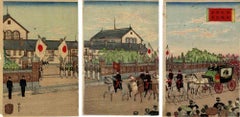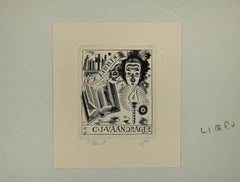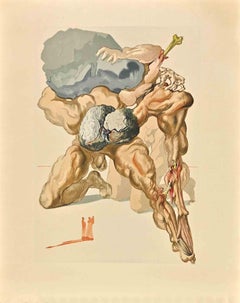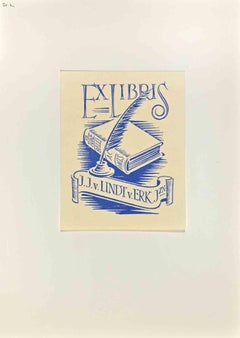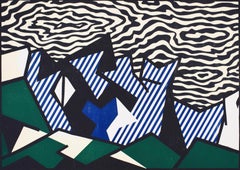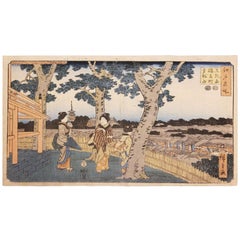Art by Medium: Woodcut
to
557
3,612
603
328
182
287
Overall Width
to
Overall Height
to
52
759
3,586
621
30
104
442
316
160
222
499
169
166
121
27
2,536
614
259
215
201
109
58
45
42
26
5
3
1
3,539
1,331
119
2,433
1,280
909
857
630
501
466
436
398
369
356
278
239
217
209
186
175
150
134
110
5,019
184,068
97,009
77,949
75,948
170
151
112
57
50
488
2,370
2,005
1,907
Medium: Woodcut
The Opening of the Temporary Diet - Woodcut by Ginko Adachi- 1890s
Located in Roma, IT
Picture of the opening of the temporary Diet building is an original artwork realized in the 1890s by Ginko Adachi (born 1853; active c. 1870 – 1908).
Sheet dimensions: 22 x 48 cm.
...
Category
1890s Modern Art by Medium: Woodcut
Materials
Woodcut
Ex-Libris - C.J. Vaandrager - woodcut - Mid 20th Century
Located in Roma, IT
Ex-Libris - C.J. Vaandrager is an Artwork realized in Mid 20th Century.
Etching on paper. Hand signed in pencil.
Good conditions.
The artwork represents a minimalistic, clean desi...
Category
Mid-20th Century Modern Art by Medium: Woodcut
Materials
Woodcut
The Avaricious - Woodcut Print - 1963
Located in Roma, IT
The Avaricious - from the Series "The Divine Comedy" - Song 7- Hell - is a woodcut print realized in 1963 for a series illustrating the Medieval poem of the "Divine Comedy" by Dante Alighieri. Not signed, as issued. Plate n.7 (as reported on the back of the artwork) that depicts a scene from Hell.
Good conditions.
Limited edition of 2900, realized by Unione Editoriale, Italy.Ref. Michler-Lopsinger no. 1039/1138, pp.102/114. Prov. Private Collection Rome, Italy.
Between 1951 and 1960, Dali was invited by the Italian government to commemorate the birth of Dante Alighieri, Italy’s most famous poet, by producing a series of illustrations for a full-text Deluxe edition of Dante’s masterpiece, the "Divine Comedy". However, in 1958 a new government was elected in Italy, which objected the idea of entrusting the illustration of the "Divine Comedy" to a foreign artist. As a result, Dali decided to offer the project to the French publisher, Joseph Forêt and the publication was completed on November 23rd, 1963. Dalí painted...
Category
1960s Surrealist Art by Medium: Woodcut
Materials
Woodcut
Ex Libris - J.J. V. Lindt - woodcut - Mid 20th Century
Located in Roma, IT
Ex Libris - J.J. V. Lindt is a Modern Artwork realized in the mid-20th Century.
Woodcut print on paper.
The work is glued on a cardboard.
Good conditions.
Category
Mid-20th Century Modern Art by Medium: Woodcut
Materials
Woodcut
Morton A. Mort, from: Expressionist Woodcut Series - Pop Art Expressionism
Located in London, GB
This original woodcut in colours with embossing is hand signed in pencil "R. Lichtenstein" at the lower right margin. It is dated ‘80’ [1980] next to the signature.
It is also number...
Category
1980s Pop Art Art by Medium: Woodcut
Materials
Woodcut
Saruwaka-machi District and Kinryûzan Temple Seen from Matsuchiyama
Located in Houston, TX
Three women in the Saruwaka-machi District with a view of Kinryûzan Temple seen from the famous landmark Matsuchiyama. The woodblock print is from the series "Famous Places in Edo". ...
Category
1850s Edo Art by Medium: Woodcut
Materials
Woodcut
Serpientes Cafe - Figurative Abstract Woodcut
Located in Soquel, CA
Figurative abstract woodcut print titled "Serpientes Cafe" by Cecelia Sánchez Duarte. Pencil signed with "P/A" (Artist Proof), title, and signature bottom margin. Image, 31"H x 23.25"W.
Sanchez Duarte is a visual artist and a cultural activist. Cecelia also teaches Art History at Escuela Profesional de Danza de Mazatlán, is the Fine Arts Coordinator at Centro Municipal de Artes, cofounder of the new Técnico en Artes Plásticas and founder of a painting workshop for children. She has had more than 300 collective exhibits internationally as well as 17 solo shows. Cecelia Sánchez Duarte lives in Mazatlán, Mexico. Cecilia Sánchez Duarte became the new director of the Art Museum of Mazatlan in 2017. Cecilia Sanchez Duarte works in printmaking at the Taller Experimental de Estampa Jose Guadalupe Posada...
Category
1990s Folk Art Art by Medium: Woodcut
Materials
Archival Paper, Woodcut
$1,200 Sale Price
20% Off
Panorama d'un Paysage - Woodcut by Utagawa Kunisada - Mid-19th Century
Located in Roma, IT
This beautiful woodcut print in the tradutional "oban" format is the work of the great Japanese master Utagawa Hiroshige (1797-1858).
It represents the landscape from a high point o...
Category
Mid-19th Century Modern Art by Medium: Woodcut
Materials
Woodcut
Sailor Man in 1579 - Woodcut Print by Charles Sterns - Early 20th Century
Located in Roma, IT
Sailor Man in 1579 is a woodcut print on creamy color paper print on paper realized by Charles Sterns in the early 20th century
Good conditions.
The artwo...
Category
Early 20th Century Modern Art by Medium: Woodcut
Materials
Woodcut
Jacob Pins (1917-2005) - 1992 Woodcut, Jack Checking Eishi
By Jacob Pins
Located in Corsham, GB
This fascinating print depicts the Art Historian Jack Hillier, a specialist in Japanese prints, books and paintings. As well as being an avid collector, he also worked as a cataloger for Sotheby's for 25 years and his book 'Japanese Masters of the Color Print' was published by Phaidon Press in 1954.
This delightful woodblock print shows the bold silhouette of Jack Hiller...
Category
1990s Art by Medium: Woodcut
Materials
Woodcut
$370 Sale Price
20% Off
Blue Face from the Brushstroke Figures Series
Located in Miami, FL
Lithograph, waxtype woodcut and screenprint on 638-g/m cold-pressed Saunders Waterford Paper. From the "Brushstroke Figures" series, 1989. Hand signed rf Lichtenstein, dated ('89) a...
Category
1980s Contemporary Art by Medium: Woodcut
Materials
Lithograph, Screen, Woodcut
Blessed are the merciful / - The support of care -
Located in Berlin, DE
Nehmer, Rudolf (1912-1983), Blessed are the merciful, 1948
Rudolf Nehmer (1912 Bobersberg - 1983 Dresden), Blessed are the merciful, 1948. Woodcut on yellowish wove paper, 18.8 cm x ...
Category
1940s Realist Art by Medium: Woodcut
Materials
Woodcut
The Artist - Original Woodcut by René Perrot - Mid-20th Century
Located in Roma, IT
The Artist is an original Woodcut print realized by René Perrot in the Mid-20th century.
Good conditions.
Signed on the plate.
The artwork is depicted t...
Category
Mid-20th Century Modern Art by Medium: Woodcut
Materials
Woodcut
Eagle Owl - Woodcut Print by Alexander Francis Lydon - 1870
Located in Roma, IT
Eagle Owl is a modern artwork realized in 1870 by the British artist Alexander Francis Lydon (1836-1917) .
Woodcut print, hand colored, published by London...
Category
1870s Modern Art by Medium: Woodcut
Materials
Woodcut
Shoveler - Woodcut Print by Alexander Francis Lydon - 1870
Located in Roma, IT
Shoveler is a modern artwork realized in 1870 by the British artist Alexander Francis Lydon (1836-1917) .
Woodcut print, hand colored, published by London, Bell & Sons, 1870. Nam...
Category
1870s Modern Art by Medium: Woodcut
Materials
Woodcut
Portrait - Original Woodcut Print by Mario Vellani Marchi - 1925
By Mario Vellani Marchi
Located in Roma, IT
The Portrait is an original Woodcut print realized by Mario Vellani Marchi (1895 – 1979)
Good conditions.
The artwork is depicted through perfect hatching in a well-balanced compos...
Category
1920s Modern Art by Medium: Woodcut
Materials
Paper, Woodcut
A Merry Christmas original wood engraving by Thomas Nast 1880
Located in Paonia, CO
Thomas Nast is one of America’s great illustrators and is responsible for creating the image of Santa Claus as we know him today. This is a hand-colored wood engraving from the cover...
Category
1880s Other Art Style Art by Medium: Woodcut
Materials
Woodcut
Utagawa Kuniyoshi -- Kinpyoshi Yorin, hero of the Suikoden
Located in BRUCE, ACT
Utagawa Kuniyoshi
Kinpyoshi Yorin, hero of the Suikoden, between 1826 and 1830
from the set The one hundred and eight heroes of the popular Suikoden, one by one (Tsuzoku Suikoden go...
Category
1850s Art by Medium: Woodcut
Materials
Woodcut
Tropical Palm Block Print
Located in Soquel, CA
Wonderful tropical Woodcut print of Palm Tree on island. Signed "Wessels" with a KW chop in a box above and 2012 lower edge. Presented in speckled pain...
Category
2010s American Impressionist Art by Medium: Woodcut
Materials
Ink, Rice Paper, Woodcut
Roy Lichtenstein GREEN FACE Lithograph & Screenprint, 58.5"H
Located in Lake Worth Beach, FL
Artist/Designer; Manufacturer: Roy Lichtenstein (American, 1923-1997)
Marking(s); notes: signed, blind stamp, marking(s); PP 1/2 aside from the edition of 60; 1989
Materials: lithogr...
Category
1980s Pop Art Art by Medium: Woodcut
Materials
Screen, Lithograph, Woodcut
Two Samurai Fighting with a Stick - Woodcut by Kunichika Toyohara
Located in Roma, IT
Two Samurai Fighting with a Stick is a Japanese multi-colored print realized around the end of the XIX Century by Toyohara Kunichika (Edo period, 1835 - 1900).
Original Woodcut on p...
Category
1880s Art by Medium: Woodcut
Materials
Woodcut
Jesus and the Disciples - Original Woodcut print by François Bouchot - 1922
Located in Roma, IT
Jesus and the Disciples is an Original woodcut print realized by François Bouchot in 1922.
The artwork is in good condition and included a brown cardboard passpartout (36.5x27.5 cm).
No signature.
François Bouchot (1800-1842), peintre et graveur, est né à Paris en 1800. Il étudia la gravure sous la direction de Richomme, puis devint élève de Regnault, puis de Lethière, et obtint le grand prix...
Category
1920s Modern Art by Medium: Woodcut
Materials
Woodcut
Sumo - Woodcut by Utagawa Kunisada - Mid 19th century
Located in Roma, IT
Sumo Tournament is a Woodcut print realized in the first half of the 19th century by Utagawa Kunisada.
Good condition and Beautiful colored woodblock print.
This wonderful modern artwork represents Japanese Sumo...
Category
Mid-19th Century Modern Art by Medium: Woodcut
Materials
Woodcut
Wigeon- Woodcut Print by Alexander Francis Lydon - 1870
Located in Roma, IT
Wigeon is a modern artwork realized in 1870 by the British artist Alexander Francis Lydon (1836-1917).
Woodcut print on ivory-colored paper.
Hand-colored, published by London, Bell...
Category
1870s Modern Art by Medium: Woodcut
Materials
Woodcut
The Rabbit - Original Woodcut by Giselle Hallf - Early 20th Century
Located in Roma, IT
The Rabbit is an original woodcut print by Giselle Hallf in the first half of the 20th Century.
Good conditions.
The artwork is depicted through strong strokes in a well-balanced c...
Category
Early 20th Century Modern Art by Medium: Woodcut
Materials
Woodcut
Portrait of Giorgio Morandi - Woodcut Print by Mino Maccari - 1950s
By Mino Maccari
Located in Roma, IT
Portrait of Giorgio Morandi is an original modern artwork realized the half of the XX Century by the Italian artist Mino Maccari (Siena, 1898 - Rome, 1989).
Original woodcut print o...
Category
1950s Modern Art by Medium: Woodcut
Materials
Woodcut
wood engraving for Mille Nuits
Located in Henderson, NV
Medium: wood engraving (after the watercolor). Printed in Paris in 1955 at the atelier Coulouma for "Mille nuits et une nuit" (1001 Nights) which was the last major portfolio by Kees...
Category
1950s Art by Medium: Woodcut
Materials
Engraving, Woodcut
Redstart - Woodcut Print by Alexander Francis Lydon - 1870
Located in Roma, IT
Redstart is a modern artwork realized in 1870 by the British artist Alexander Francis Lydon (1836-1917) .
Woodcut print, hand colored, published by London, Bell & Sons, 1870. Name...
Category
1870s Modern Art by Medium: Woodcut
Materials
Woodcut
Serena - Original Woodcut Print by Arturo Martini - 20th Century
Located in Roma, IT
Serena is an original woodcut realized by Arturo Martini. Title and signature printed on the lower margin.
The State of preservation is good.
The artwork is representing a woman beside a vase of flowers in a frame through intense bla...
Category
20th Century Art by Medium: Woodcut
Materials
Woodcut
Seibutsu (Still Life) A Vase and Apples
Located in Fairlawn, OH
Seibutsu (Still Life)
A Vase and Apples
Color woodcut, 1925
Signed on the mount (support sheet)
From: Dojin zasshi, Hanga Magazine, Volume 8, No. 8
Condition: Excellent
Image/Sheet ...
Category
1920s Showa Art by Medium: Woodcut
Materials
Woodcut
Seki Station - Woodcut after Utagawa Hiroshige - 1890s
Located in Roma, IT
Seki Station is an original modern artwork realized after Utagawa Hiroshige in the Late 19th Century.
Original Woodcut print From the Famous "Tokaido Se...
Category
1890s Modern Art by Medium: Woodcut
Materials
Woodcut
Portrait of Felix Faure - Woodcut Print by F. Vallotton
Located in Roma, IT
Signed on plate with Felix Vallotton's F.V. monogram.
Image Dimensions : 16 x 12.5 cm
Passepartout included : 39.5 x 34.5 cm
This artwork is shipped from Italy. Under existing legis...
Category
Late 19th Century Post-Impressionist Art by Medium: Woodcut
Materials
Woodcut
Gadwall - Woodcut Print by Alexander Francis Lydon - 1870
Located in Roma, IT
Gadwall is a modern artwork realized in 1870 by the British artist Alexander Francis Lydon (1836-1917) .
Woodcut print, hand colored, published by London, Bell & Sons, 1870. Name...
Category
1870s Modern Art by Medium: Woodcut
Materials
Woodcut
Jay - Woodcut Print by Alexander Francis Lydon - 1870
Located in Roma, IT
Jay is a modern artwork realized in 1870 by the British artist Alexander Francis Lydon (1836-1917).
Woodcut print on ivory-colored paper.
Hand-colored, published by London, Bell & ...
Category
1870s Modern Art by Medium: Woodcut
Materials
Woodcut
Plate 12
Located in Fairlawn, OH
Plate 12
From: 10 Origi, 1942
Signed in the block with the artist's initials lower left (printed)
From: 10 Origin
Not from the First edition 100, published by Allianz-Verlag, Zurich,...
Category
1970s Expressionist Art by Medium: Woodcut
Materials
Woodcut
Pura Vida, 1985, (A/P)
Located in Milwaukee, WI
Woodcut in colors on Japanese paper. Signed and titled by artist.
24.25" x 24.25" art
34.88" x 34.63" frame
Carol Summers (1925-2016) has worked as an artist throughout the second ...
Category
1980s Art by Medium: Woodcut
Materials
Woodcut
Apple
Located in London, GB
Rachel Howard
Apple, 2016
Woodcut print
48 × 39.8 cm
Edition of 25
Rachel Howard is a contemporary British artist known for her dynamic and emotive paintings that explore themes of ...
Category
2010s Contemporary Art by Medium: Woodcut
Materials
Woodcut
$1,099
Portrait - Woodcut by Lorenzo Viani - 1930
Located in Roma, IT
Portrait is an original woodcut on paper, realized by the Italian Artist Lorenzo Viani in 1930 ca.
The State of preservation is excellent.
Monogrammed...
Category
1930s Modern Art by Medium: Woodcut
Materials
Woodcut
Little Egret - Woodcut Print by Alexander Francis Lydon - 1870
Located in Roma, IT
Little Egret is a modern artwork realized in 1870 by the British artist Alexander Francis Lydon (1836-1917).
Woodcut print on ivory-colored paper.
Hand-colored, published by London...
Category
1870s Modern Art by Medium: Woodcut
Materials
Woodcut
Nir Hadar, The princess from Jaffa, Print on wood
Located in Tel Aviv, IL
Hadar takes euphoric moments and try to generate a three dimensional feeling with every image inviting the viewer to jump into the game and to be part of it.
There's a hidden message...
Category
2010s Pop Art Art by Medium: Woodcut
Materials
Woodcut
Portrait - Original Charcoal Drawing by Hélène Vogt - 1970s
Located in Roma, IT
Portrait is an original xilography print realized by Hélène Vogt. with the stamp” Atelier Hélène Vogt" On the lower rear.
The state of preservation of the artwork is very good.
Sh...
Category
1970s Art by Medium: Woodcut
Materials
Woodcut
Portrait - Woodcut on Paper - 20th Century
Located in Roma, IT
Portrait is original xylography on paper realized by an Anonymous artist of the XX century. Monoprint, signed on the plate
In very good condition.
Sheet dimension: 26 x 19.5 cm.
I...
Category
20th Century Modern Art by Medium: Woodcut
Materials
Woodcut
Scaup - Woodcut Print by Alexander Francis Lydon - 1870
Located in Roma, IT
Scaup is a modern artwork realized in 1870 by the British artist Alexander Francis Lydon (1836-1917) .
Woodcut print, hand colored, published by London, Bell & Sons, 1870. Name of...
Category
1870s Modern Art by Medium: Woodcut
Materials
Woodcut
Sailor - Woodcut Print by Lorenzo Viani - 1930 ca.
Located in Roma, IT
Sailor is an original xilograph on ivory-colored, realized by the Italian Artist Lorenzo Viani in 1930ca.
Monogram of the artist on the lower left" LV"....
Category
1930s Modern Art by Medium: Woodcut
Materials
Woodcut
Egyptian Vulture - Woodcut Print by Alexander Francis Lydon - 1870
Located in Roma, IT
Egyptian Vulture is a modern artwork realized in 1870 by the British artist Alexander Francis Lydon (1836-1917) .
Woodcut print, hand colored, publi...
Category
1870s Modern Art by Medium: Woodcut
Materials
Woodcut
The Romantic Kiss - Woodcut rint by Paul Baudier - 1930s
Located in Roma, IT
The Romantic Kiss is a woodcut print on ivory-colored paper realized by Paul Baudier (1881-1962) in the 1930s.
Good conditions.
Paul Baudier, (born October 18, 1881 in Paris and di...
Category
1930s Modern Art by Medium: Woodcut
Materials
Woodcut
Horizontal 'Spots' II, Minimalist Woodcut Print, 2018
By Damien Hirst
Located in New York, NY
The minimalist's dream, the large-scale iconic contemporary pop art Horizontal 'Spots' with multi-color dots by Damien Hirst is one of fifty-five limited edition woodcut prints on So...
Category
2010s Contemporary Art by Medium: Woodcut
Materials
Woodcut
$60,000 Sale Price
20% Off
Man with the Dragon - Woodblock Print by Utagawa Toyokuni I - 1800 ca
Located in Roma, IT
Man with the Dragon is a superb color woodbloock print on rice-paper, realized by the great master of ukiyo-e print, Utagawa Toyokuni I (1769-1825)
Depicti...
Category
Early 1800s Art by Medium: Woodcut
Materials
Paper, Woodcut
Rare Scene of Nobility on Palanquins Over Water, Ukiyo-e Style Woodcut
Located in New York, NY
Ukiyo-e Style Woodcut
Untitled, c. 1900
Woodcut print
Sight: 13 1/2 x 28 3/4 in.
Framed: 22 1/4 x 37 1/4 in.
Category
Early 1900s Other Art Style Art by Medium: Woodcut
Materials
Woodcut
Wedding Party
Located in Buffalo, NY
An original mid century modern woodblock print.
This work is hand signed illegibly and titled "Wedding Party".
Category
1960s Modern Art by Medium: Woodcut
Materials
Paper, Woodcut
$400 Sale Price
38% Off
The Protest - Woodcut Print by Paul Baudier - 1930s
Located in Roma, IT
The Protest is a woodcut print on ivory-colored paper realized by Paul Baudier (1881-1962) in the 1930s.
Good conditions.
Paul Baudier, (born October 18...
Category
1930s Modern Art by Medium: Woodcut
Materials
Woodcut
Standing Nude - Original Woodcut On Rigid Paper- 1976
Located in Roma, IT
Standing Nude is a original artwork realized in 1976 by the Spanish artist José A.Benasalvas.
Original Woodcut on rigid paper.
Edition of 25 prints. Hand-signed by the artist on t...
Category
1970s Modern Art by Medium: Woodcut
Materials
Woodcut
Japanese Actors - Woodcut by Utagawa Kunisada - 19th Century
Located in Roma, IT
Japanese Actors is a superb colored woodcut realized in the XIX century by one of the most famous Japanese Ukiyo-e artists: Utagawa Kunisada, also know...
Category
19th Century Art by Medium: Woodcut
Materials
Woodcut
Portrait of Stefan George - Woodcut by Reinhold Lepsius- Early 1900
Located in Roma, IT
"Portrait of Stefan George" is an original woodcut on brown-colored paper, realized by Reinhold Lepsius (1857-1922).
The state of preservation of the ar...
Category
Early 20th Century Symbolist Art by Medium: Woodcut
Materials
Woodcut
Kabukie - Woodcut by Ichiyôsai Yoshitaki - 1860s
Located in Roma, IT
Kabukie is an original artwork realized in the 1861 by Ichiyôsai Yoshitaki.
Woodcut Print.
The actor Onoe Tomizo as Ishii Genzo and Jitsugawa Ensaburo as Isshi Hyosuke in the 9th a...
Category
1860s Modern Art by Medium: Woodcut
Materials
Woodcut
Osakae - Woodcut by Ichiyôsai Yoshitaki - 1860s
Located in Roma, IT
Osakae is an original artwork realized in the 1861 by Ichiyôsai Yoshitaki.
Woodcut print Chuban Diptych.
The actor Nakamura Jakuemon I as Matsushita Kaheiji, Arashi Rikan III as Ak...
Category
1860s Modern Art by Medium: Woodcut
Materials
Woodcut
Portrait of the Actor Kata - Woodcut Print by Sadayoshi Utagawa - 1848
Located in Roma, IT
Portrait of the actor Kataoka Gado II as Fukumasuya is an original modern artwork realized by Sadayoshi Utagawa in 1848.
Original Woodcut print Chuban Format.
Half-length portrait of the actor Kataoka Gado II as Fukumasuya Daisuke and his son Akeshi Tsuru Wakamaru.
Signed: Sadayoshi ga. Publisher: Shii.
Excellent impression with blindstamping (design in purple robe) and bokashi, slightly faded soiled yellowed and rubbed, centrefold.
Sadayoshi Utagawa was a printmaker and poet and presumably a pupil of Kunisada...
Category
19th Century Modern Art by Medium: Woodcut
Materials
Woodcut
Portrait of the Actor Kawarazaki Gonjuro - Woodcut by Toyohara Kunichia - 1863
Located in Roma, IT
Portrait of the actor Kawarazaki Gonjuro is an original artwork realized in 1863 by Toyohara Kunichika (30 June 1835 – 1 July 1900)
Oban.
From the series "Karu asobi hana no senzei", The pleasures of summer in a consecated area. Breast Portrait of the actor Kawarazaki Gonjuro in yukata at night, behind in the darkness houses.
Signed: Kunichika ga.
Publisher: Izutsuya. Censored by Aratame. Wood engraver: Horicho.
Excellent impression with blind printing and glossy black printing and Kirazuri mica at upper black margin, a little bit creased.
Toyohara Kunichika (30 June 1835 – 1 July 1900) was a ukiyo-e Japanese woodblock print artist. Talented as a child, at about thirteen he became a student of Tokyo's then-leading print maker, Utagawa Kunisada. His deep appreciation and knowledge of kabuki drama...
Category
1850s Modern Art by Medium: Woodcut
Materials
Woodcut
The Radiant Prince Genji - Woodcut by Utagawa Kunisada-Mid 19th Century
Located in Roma, IT
The Radiant Prince Genji is an original artwork realized in the mid-19th Century by Utagawa Kunisada (1786-1865).
From the series "Sono sugata ukari utsushie" (Faithful Images of t...
Category
Mid-19th Century Modern Art by Medium: Woodcut
Materials
Woodcut
Fun Tim Engelland Woodcut of a Server with a Goose
Located in New York, NY
Tim Engelland (American, 1950-2012)
Untitled, 1989
Woodcut
11 x 8 1/2 in.
Signed and dated lower right
Numbered lower left 29/250
A lifelong artist, Engelland specialized in oil po...
Category
1980s Contemporary Art by Medium: Woodcut
Materials
Woodcut
Woodcut art for sale on 1stDibs.
Find a wide variety of authentic Woodcut art available on 1stDibs. While artists have worked in this medium across a range of time periods, art made with this material during the 21st Century is especially popular. If you’re looking to add art created with this material to introduce a provocative pop of color and texture to an otherwise neutral space in your home, the works available on 1stDibs include elements of orange, yellow, purple, blue and other colors. There are many well-known artists whose body of work includes ceramic sculptures. Popular artists on 1stDibs associated with pieces like this include Mino Maccari, Utagawa Kunisada (Toyokuni III), Eric Gill, and Utagawa Hiroshige. Frequently made by artists working in the Modern, Contemporary, all of these pieces for sale are unique and many will draw the attention of guests in your home. Not every interior allows for large Woodcut art, so small editions measuring 0.04 inches across are also available
